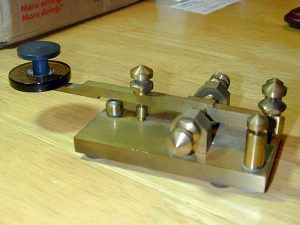

Thursday, Oct. 6, 2016 — OK, OK, I’m slacking off this morning. Should be doing actual work but I have my second cup of coffee and my to-do list at the ready.
For the past week or so, I’ve been using a homebrew straight key I picked up on eBay a few weeks ago. I’m not sure what prompted me to buy the thing, other than the fact it IS a homebrew key. As I have written before, I have a soft spot for homebrew Morse keys. I considered this one, but really  wasn’t sure about it. The seller has been selling keys and related things for quite a long time on eBay, and I have several keys I picked up from him in the past couple of years.
wasn’t sure about it. The seller has been selling keys and related things for quite a long time on eBay, and I have several keys I picked up from him in the past couple of years.
It is apparent some thought went into the key when it was being created. The key’s size and proportions are pretty nice; it is larger than a Speed-X straight key, but it doesn’t need to be mounted to anything to stay stable when in use. It has a nice satin finish over most of the parts. The key is just a very basic key, but it does show some flair of creativity; check out the lock nuts and the adjustment and terminal screws.
The lock nuts were machined down to give them a very tapered profile. If you replaced the lock nuts with stock brass nuts, the key would lose a lot of its unique appeal. The way the nuts were machine also makes them easy to adjust, and as goofy as this may sound, the lack of hard edges on the nuts makes them very comfortable to manually adjust.
I also found that I like the way the adjustment screws were machined; I initially doubted how well the tapered cone style would work in practice, but it didn’t take long to determine the screws and lock nuts were both pleasant to look at and pleasant to use.
I don’t think this key is a vintage piece, but the size of the silver contacts makes me think of the large ones typically used on spark-era keys. The key’s one modern touch is a giveaway that this piece is of more recent vintage, however. To connect the “hot” terminal to the key’s contact, the maker used  an etched PC board that mounts flat against the bottom of the key.
an etched PC board that mounts flat against the bottom of the key.
ON THE AIR. The key has a very nice feel in use. The adjustments allow you to really dial in the key to your preferences, and it operates very well with a very close contact spacing. Having recently put a Nye Master Key and the Brown Bros straight key on the air, I can’t say either has anything on this homebrew key. I like the long keying lever, which I think contributes to the key’s smoothness. It appears the Navy-style knob is homebrew; it feels smaller than a standard Navy knob, but not unusable.
I wish I could place a name and callsign with this key; it isn’t a very high-tech key, but is demonstrates the care and forethought its maker put into its design and construction.
A SCREW LOOSE? My wife frequently shakes her had and tells me, “Zedman, you’ve got more than one screw loose!” I also had some missing screws for various Vibroplex keys I have owned over the years. The screw I frequently don’t have is the small one that secures the thumb piece to the keying lever. Now I have ordered them from Vibroplex along with thumb and finger pieces, but I have a number of keys that lack the screw. It isn’t absolutely necessary, and I have operated bugs without it (just make sure the finger knob is tight). But at  $1.50 a pop, I decided I was going to try a less expensive route.
$1.50 a pop, I decided I was going to try a less expensive route.
Our local mom-and-pop hardware store (remember those?) is where I usually go to find nuts, bolts of all sizes and materials. I know that part of the store so well they no longer ask if I need some help. Anyway, the thumb piece screws are 4-40 thread screws, and I think 5/16 of an inch long. I splurged yesterday and bought 10 of them at 7 cents each. I already added screws to several keys, and keep identifying others that are missing the screw.
So there you go — if you are missing that thumb piece screw you can find them at your nearest hardware store — provided you still have a local hardware store.
